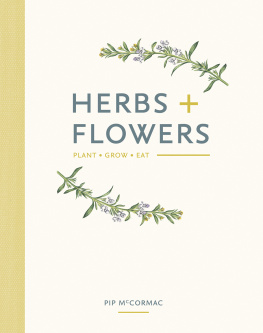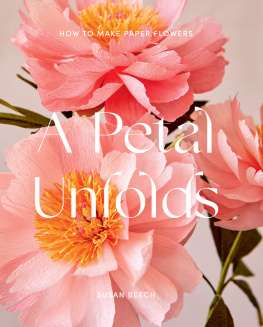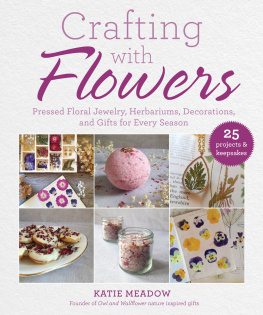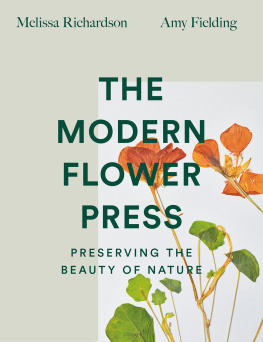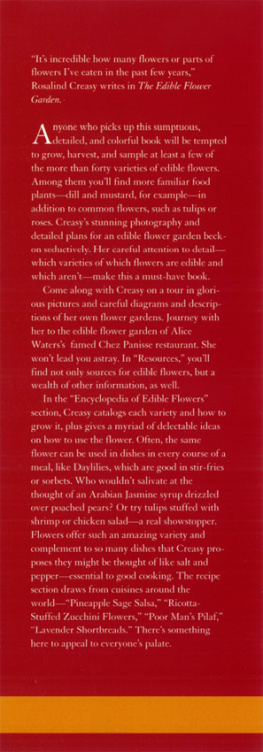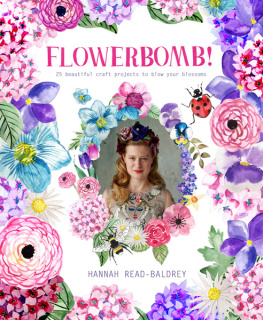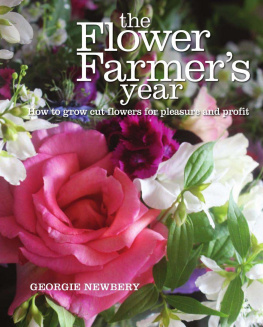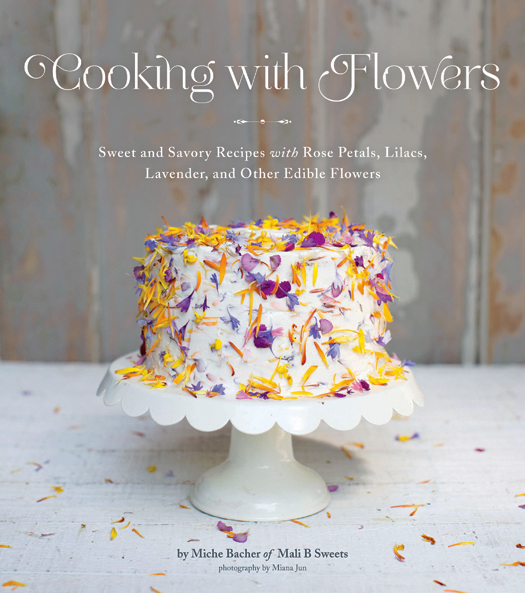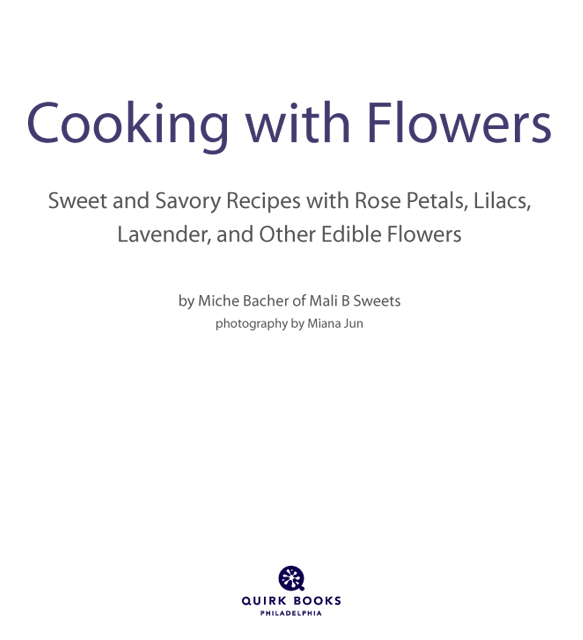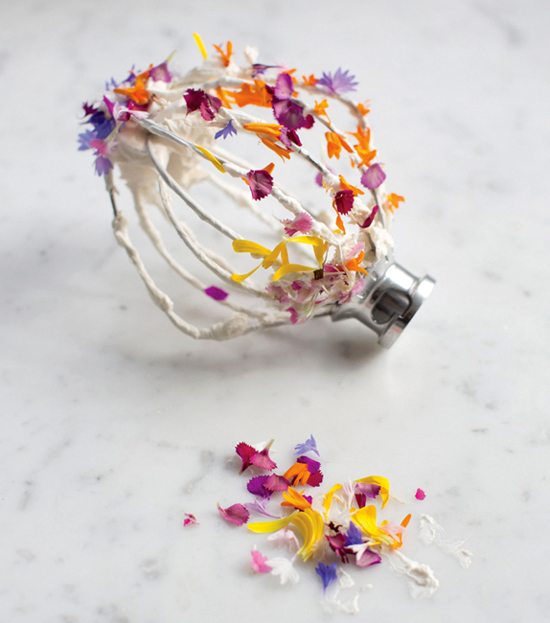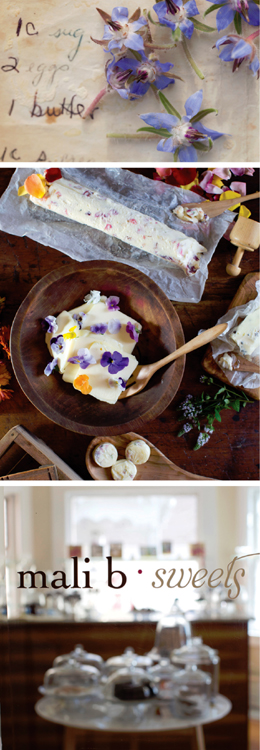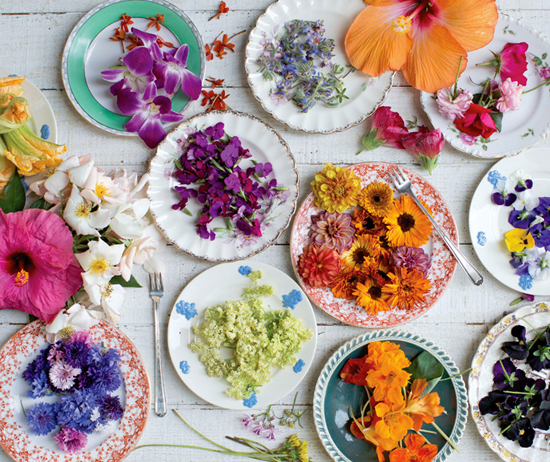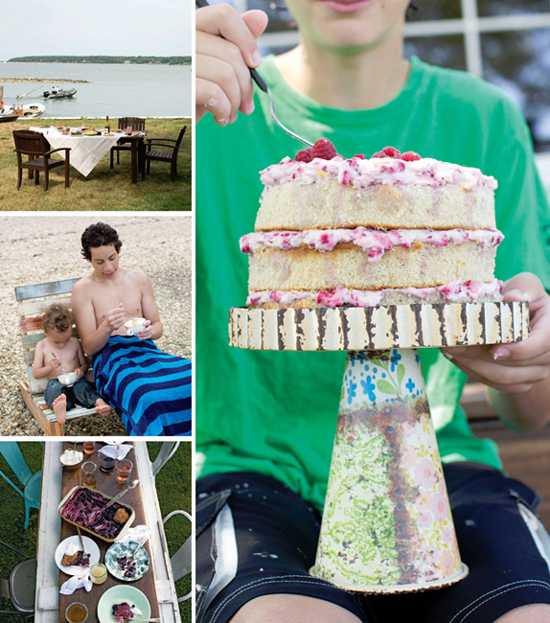Copyright 2013 by Miche Bacher
Unless indicated below, all photographs 2013 by Quirk Productions, Inc.
All rights reserved. No part of this book may be reproduced in any form without written permission from the publisher.
Library of Congress Cataloging in Publication Number: 2012936106
eISBN: 978-1-59474-667-3
Photography by Miana Jun
Additional photography by Miche Bacher: inside back cover
(portraits); Jenny Gorman: jacket flap (authors portrait);
and Anthony LaScala: jacket flap (photographers portrait)
All used by permission of the photographers.
Prop styling by Miche Bacher, Miana Jun,
Nanao Anton, Kristine Trevino, and Anthony LaScala
Production management by John J. McGurk
Quirk Books
215 Church St.
Philadelphia, PA 19106
quirkbooks.com
Disclaimer:
Eat flowers only when youre sure theyre edible and organically grown. When trying new edible flowers, introduce them to your diet in small quantities and beware of allergies. No book should be a substitute for a readers good judgment and common sense.
v3.1
This is for my boysyour Mama loves you. You will always be the most favorite flowers in my garden.
Contents
Introduction
I set out to fill this book with my favorite recipes for edible flowers. I love to cook with beauties like roses and orchids; humble potted plants like pansies and geraniums; herb flowers like chamomile, rosemary, and sage blossoms; and wild weed flowers like dandelions and violets. Some of these flowers relish their time in the cold, such as elder, and some of them thrive in the tropics, like hibiscus. Youll find that each recipe is designed to make use of a particular bloom, but I will show you how to swap blossoms when appropriate.
To give you some background information, each chapter opens with a piece about the flower, including its botanical name, nicknames, growing habits and seasonality, culinary uses, and anything special you might need to know to prepare it before cooking with it. Youll also find each flowers meaning according to the Victorian language of flowers, plus some fascinating bits of history and legend. The back of the book is filled with a collection of basic yet flavorful recipessimple classics you can make with almost any edible flower. Stock up on these, and youll have a flower-filled kitchen all year long.
Why Eat Flowers?
Whats that you say? Eat your flowers?
Its true. There are lots of flowers you can eat. Taking the time to learn which ones are edible and how to enjoy them is well worth the effort. I have been eating flowers for years and take pleasure in introducing them to others.
Flowers add color, complexity, and what I like to call the magical whats in it factor to your food. They are full of nutrients and often offer health benefits, too. You dont have to be a master gardener or trained chef to cook with flowersonce you start looking, youll realize edible blossoms are all around you, and it really is a breeze to use them. Soon youll find yourself searching farmers market and neighborhood gardens for both cultivated flowers and what some might call weeds.
Have I ever eaten one?
Many people have eaten flowers without even realizing it. If youve ever had zucchini blossoms, you have eaten a flower. Artichoke? Flower. Brussels spouts? Flower. Broccoli, cauliflower? Flower, flower. Although those are all fabulous flowers in their own right, in this book well focus on the widely available types that dont get the culinary attention they deserve.
What do flowers taste like?
Chive blossoms and nasturtiums are spicy, sunflowers are bitter, and calendula and chamomile are earthy. Lilacs can be highly perfumed, and their taste varies from slightly bitter to lemony. Roses can be sweet, with back notes of spice or mint or apple; the stronger the scent, the more pronounced the flavor. Geranium flavors vary wildly, from lime to rose to orange to mint and more. But most flowers have a fairly consistent flavor that varies subtly due to the cultivar, soil type, and growing conditions.
Dont be afraid to switch it up and try different flowers in different recipes. If you find a flower you love, try substituting it for one youre not quite fond of. Lavender is the only flower you have to be cautious with, because its flavor and aroma can be overwhelming, so start by using a lot less lavender than you think youll need. I can still hear my fathers voice echoing in my ear: You can always add, but you cant take out. And he could cook!
Are flowers good for you?
For centuries, flowers have been prized for their medicinal and cosmetic properties. Flowers have been found in Egyptian tombs. Ancient Romans used mallows, pinks, and roses. Chrysanthemums, daylilies, and orchids have long been beloved across Asia. Today, we use flower remedies in acupuncture and herbal medicinechamomile to soothe stomachaches and relax the nerves, lavender for depression, violets for coughs. Many flowers are high in vitamins and minerals like vitamins A and C, and they are all low in calories. The Memorial Sloan-Kettering Cancer Center website provides information on herbs and flowers that may be useful in cancer treatment. Its exciting to see modern medical research into each blossoms nutritional benefits and healing properties.
Flowers have also found their places in legends and myths about healing (and breaking!) relationships. Because I love a good story, I cant wait to share some of them with you, such as how the pansy got its name ().
What is the language of flowers?
Victorians cherished recipes for flower teas, cakes, and salads as well as gem-colored flower jellies, jams, and conserves. They also used flowers as a means of communication. Thats how the legendary language of flowers evolved: people would send each other single flowers, bouquets, and tussie-mussies (small symmetrical bouquets) as a means of private and highly nuanced communication. Each flower conveyed a sentiment, and sometimes different colors of flowers conveyed different meanings. So if you received a coral rose you might be the subject of desire, but if you were given a lavender one you might have enchanted someone.
From Garden to Table
So, are there rules about eating flowers? In a couple words: you betcha! When grown organically, flowers like roses, lilacs, and little herb blossoms are full of flavor, color, and nutrients. But whether youre buying them in a store or gathering them yourself, you must use your best judgment and follow these basic rules.





